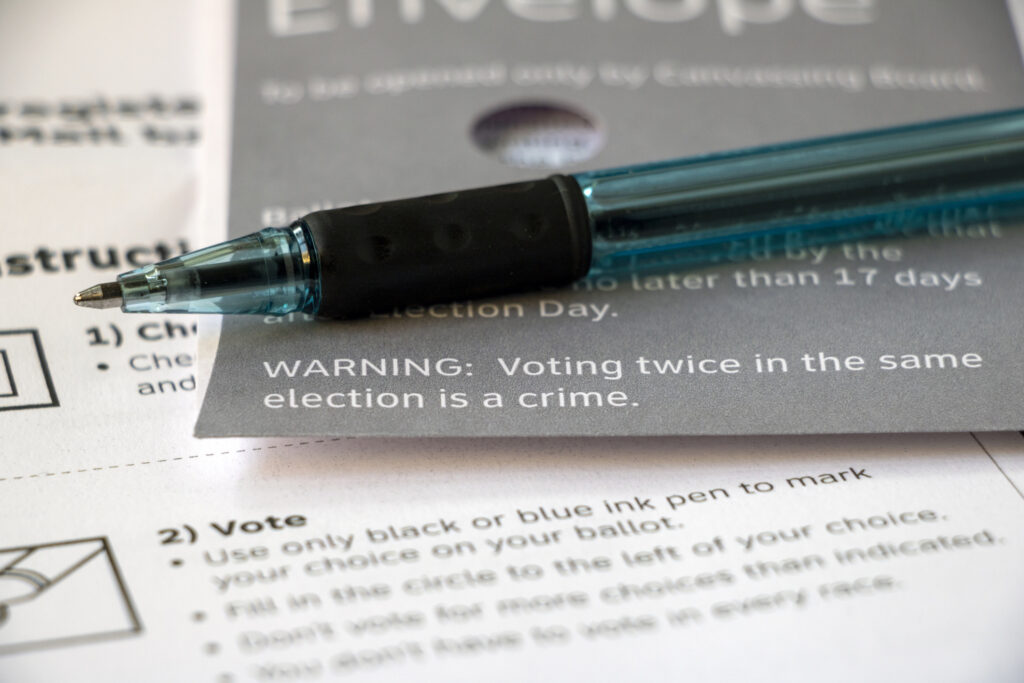Impartial elections are absolutely essential to a cohesive and fruitful society. Historically, Americans have generally trusted that national elections have been free, fair, and secure, as well as bereft of widespread fraud. For generations, the majority of Americans have trusted that the electoral results delivered to the public were an accurate reflection of the will of the people. However, this time-honored tradition changed after the 2020 election. In the wake of the COVID-19 global pandemic, dozens of states significantly altered their voting processes. In many cases, these changes occurred imprudently, without serious consideration of their potentially adverse effects and without the consent of the people’s elected representatives in state legislatures.
These abrupt and hasty changes to voting procedures in the months before the 2020 election occurred despite the fact that ample evidence showed that mass mail-in voting, unsecure ballot drop boxes, ballot harvesting, and lack of signature verification would result in a flood of fraudulent ballots that would undermine the accuracy of the election results.
This paper examines the likely impact that fraudulent mail-in ballots cast for both Joe Biden and Donald Trump in the 2020 election could have had upon the overall electoral results, based upon recently unearthed evidence indicating widespread mail-in voter fraud indeed occurred in the 2020 election. After summarizing the problems associated with mail-in voting, we discuss the results of a groundbreaking poll conducted by The Heartland Institute and Rasmussen Reports in November/ December 2023, which attempted to definitely assess the degree of fraudulent voting that took place in the 2020 election.
The results of the survey are nothing short of stunning, and upon their release, they sparked numerous conversations about the amount of fraud in the 2020 election and the potential impact of mail-in ballot fraud in future elections. For example, former President Trump referred to the poll as “the biggest story of the year” and “the most important poll released in the past 20 years.” According to the results of the survey, a massive number of voters who cast ballots by mail admitted to committing at least one form of voter fraud in the 2020 election. Some of the most important findings from the poll include:
- 21 percent of mail-in voters admitted that in 2020 they voted in a state where they are “no longer a permanent resident.”
- 21 percent of mail-in voters admitted that they filled out a ballot for a friend or family member.
- 17 percent of mail-in voters said they signed a ballot for a friend or family member “with or without his or her permission.”
- 19 percent of mail-in voters said that a friend or family member filled out their ballot, in part or in full, on their behalf.
After analyzing the raw survey data, we were also able to conclude that 28.2 percent of respondents who voted by mail admitted to committing at least one kind of voter fraud. This means that more than one-in-four ballots cast by mail in 2020 were likely cast fraudulently, and thus should not have been counted.
Because Joe Biden received significantly more mail in votes than Donald Trump, we conclude that the 2020 election outcome would have been different in the key swing states that Donald Trump lost by razor thin margins in 2020—Arizona, Georgia, Michigan, Nevada, Pennsylvania, and Wisconsin— under the 28.2 percent scenario. We also analyzed the electoral results for those six swing states under every integer from 27 percent fraud down to 1 percent fraud, allowing readers to see the impact that fraudulent mail-in ballots might have produced under each scenario.
We made a number of assumptions and gathered our data from a variety of sources in addition to our poll, which is detailed in the methodology and data sections.
The results of our analysis are outlined below.
- 28.2 percent fraud
- Trump wins Arizona, Georgia, Michigan, Nevada, Pennsylvania, and Wisconsin.
- Trump wins the Electoral College 311-227.
- 27 percent fraud through 14 percent fraud
- From 27 percent fraud down through 14 percent, the overall results are identical to the 28.2 percent fraud scenario (though Trump’s margin of victory in each state shrinks as the overall mail-in ballot fraud integer shrinks).
- 13 percent fraud through 6 percent fraud
- Trump wins Arizona, Georgia, Pennsylvania, and Wisconsin, but loses to Biden in Michigan and Nevada.
- Trump wins the Electoral College 289-249.
- 5 percent fraud and 4 percent fraud
- Trump wins Arizona, Georgia, and Wisconsin, but loses to Biden in Michigan, Nevada, and Pennsylvania.\
- Trump and Biden tie the Electoral College 269-269. As described in more detail in the paper, Trump would likely have won the resulting vote in the House of Representatives, because Republicans controlled more state delegations in the wake of the 2020 election.
- 3 percent fraud
- Trump wins Arizona and Georgia, but loses to Biden in Michigan, Nevada, Pennsylvania, and Wisconsin.
- Biden wins the Electoral College 279-259.
- 2 percent fraud and 1 percent fraud
- Trump does not win any states. Biden wins Arizona, Georgia, Michigan, Nevada, Pennsylvania, and Wisconsin.
- Biden wins the Electoral College 306-232.
We also include a scenario in which Trump and Biden voters committed fraud at different rates, stemming from the differences in self-admitted mail-in voter fraud among Trump and Biden voters from the Heartland/Rasmussen survey. However, due to its small sample size, the margin of error for these estimates is too high to produce statistically reliable results. Our analysis indicates that at the 28.2 percent fraud rate, Biden voters admitted to committing at least one form of fraud at a rate of 23.2 percent, and Trump voters self-admitted fraud rate was 35.7 percent. Even under this scenario, Trump would have defeated Biden in Georgia, Pennsylvania, and Wisconsin, and won the Electoral College 278-260.
Ultimately, our study shows that of the 29 different scenarios presented in the paper, Trump would have won the 2020 election in all but three (when mail-in ballot fraud is limited to 1–3 percent of the ballots counted). Hence, even if the level of fraud detected in our survey (28.2 percent of all mail-in ballots) substantially overstates the actual level of fraud that occurred, Trump would likely have won the 2020 election anyway. We have no reason to believe that our survey overstated voter fraud by more than 25 percentage points, and thus, we must conclude that the best available evidence suggests that mail-in ballot fraud significantly impacted the 2020 presidential election, in favor of Joe Biden. In other words, had the 2020 election been conducted like every national election has been over the past two centuries, wherein the vast majority of voters cast ballots in-person rather than by mail, Donald Trump would have almost certainly been re-elected.
The paper concludes with a list of commonsense policy recommendations states should establish to improve or maintain election integrity.
- Proactive policies
- States should update and verify election registration rolls annually.
- States should require identification to vote in person.
- States should encourage in-person voting.
- States should require a witness or notary signature on all mail-in ballots.
- States should minimize mail-in voting by requiring a valid excuse to cast a ballot by mail.
- Preventative policies
- States should outlaw ballot harvesting.
- States should forbid unattended and unsecure election drop boxes.
- States should require signature verification for mail-in voting.
- States should establish agencies to investigate claims of election law violations.
- States and/or the federal government should pass laws that impose harsh penalties for those who commit voter fraud.
We believe policies designed to thwart mass mail in balloting are the best way for states to ensure the integrity of future elections, considering that more than one-in-four mail-in ballots in the 2020 presidential election were cast fraudulently, based on the aforementioned poll results. It is our view that there are only two ways to ensure that mail-in voter fraud does not have a substantial impact in future elections. First, states should require that most people vote in person, unless they have a valid excuse. Interestingly, according to the previously cited poll, 94 percent of voters said they would vote in-person if their state banned mail in voting in future elections. Although in-person voting remains the best option to prevent mail-in fraud from having an outsized effect on election results, in some states, mandating that most voters go to the polls in person is not a realistic option. Therefore, our second method of improving election integrity should be strongly considered: lawmakers should pass legislation that makes mail-in voting significantly more secure.
The best way to prevent fraud in mail-in balloting is to require that mail-in voters have their ballot signatures verified by a notary. States that choose to require a notarized signature for mail in ballots might also consider a policy that makes government notaries available for free for mail-in voters, or perhaps a program that reimburses notary costs related to verifying ballot signatures. State lawmakers could also consider programs that provide notaries remotely, or that send notaries to homes in extraordinary circumstances. The costs of these and other, similar programs should be minimal, but even if they were not, lawmakers should not put a price limit on election integrity. Another valid but much less secure option would be to mandate that mail-in ballot envelopes include the address and signature of an adult witness, who would attest under law that he or she saw the voter sign the ballot envelope.
The 2023 Heartland Institute/ Rasmussen voter fraud survey and the deductions from this paper clearly demonstrate that mail-in ballot fraud is a significant issue, which must be addressed sooner than later. If state lawmakers fail to solve this problem, Americans’ confidence in the legitimacy of elections in 2024 and beyond will likely decrease, paving the way for societal chaos and civil unrest.








